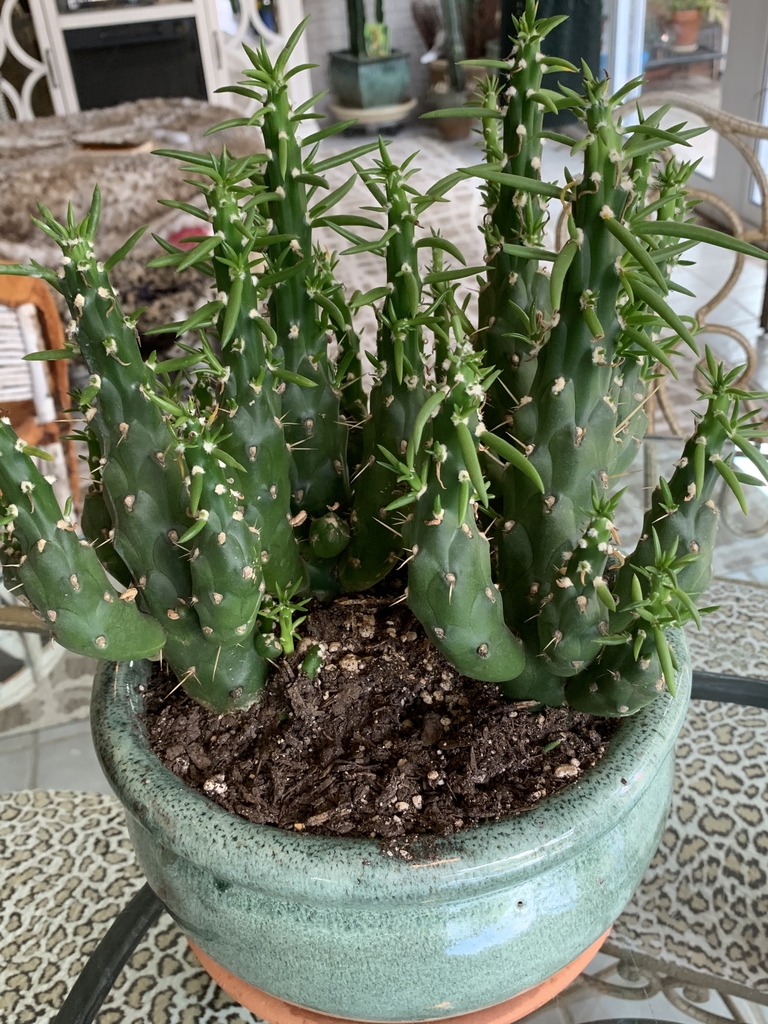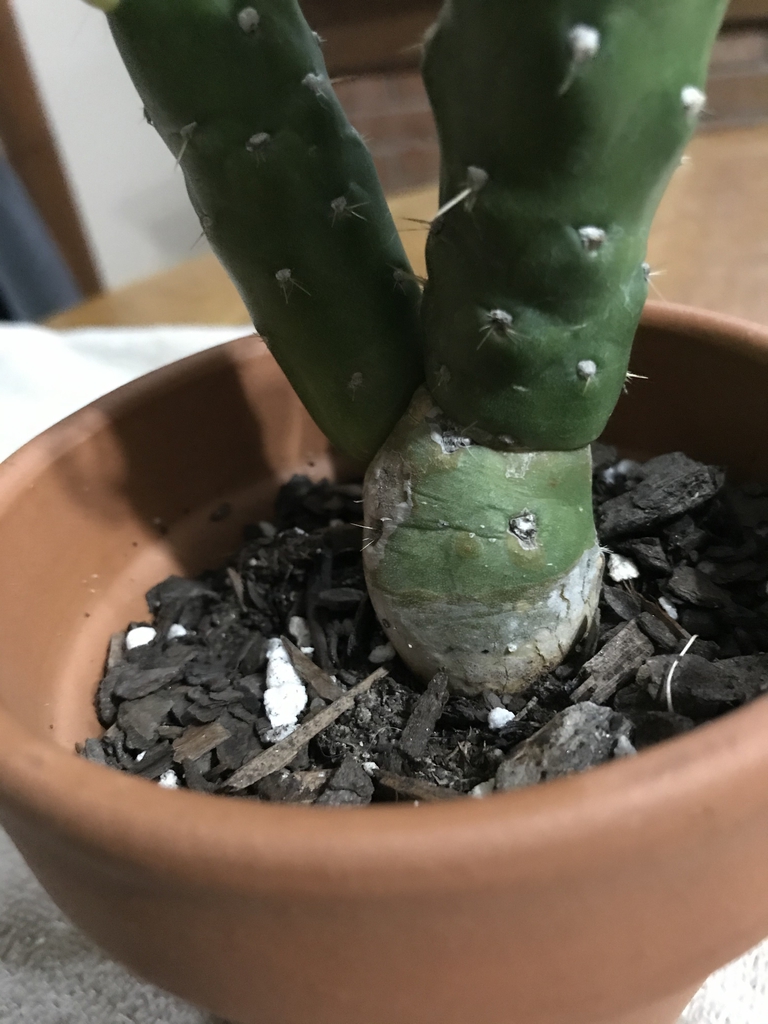Eve's Pin Cactus Austrocylindropuntia subulata
Other Common Name(s):
Previously known as:
- Opuntia subulata
- Pereskia subulata
- Phonetic Spelling
- oss-troh-sil-in-droh-POON-tee-uh sub-yoo-LAH-tuh
- Description
-
Eve's needle cactus is a species of shrub or tree-like cactus that is native to the Peruvian Andes where it is valuable for erosion control and serves as a wildlife habitat for small animals and birds. It has long, slender stems with sharp spines and thrives in arid, desert-like conditions, and it is a member of the cactus family (Cactaceae).
This plant requires full sun or bright indoor light, good drainage, and infrequent watering. If used as a container or houseplant make sure the container or clay pot has adequate drainage holes. The recommended potting medium is cactus or succulent medium with added coarse sand, pumice, or perlite to promote good drainage. Water the plant well and allow the soil to completely dry out between waterings. This plant will not survive freezing temperatures or high humidity. It needs to be brought indoors before the first frost and placed in a sunny location. This plant is hardy in USDA Plant Hardiness Zones 9 to 11.
Eve's needle cactus may grow up to 13 feet tall in its native habitat, but is much smaller in cultivation. The trunk is erect and can measure up to 4 inches in diameter. It has elongated branches and cylinder-like joints that grow up to 2 feet long and 2.5 inches wide. It has ovate bumpy tubercles along the stems. The leaves are awl-like, fleshy, and greenish-yellow and can grow up to 5 inches long on a mature plant. The spined areoles have straight grayish-white spines that measure up to 3 inches long. Flowers bloom in the spring or summer, and they are tubular and may be yellow, greenish-yellow, orange-red, or red. The fruits produced are red and have fine stinging hairs.
This plant is low maintenance and thrives in arid-like conditions and requires very little watering. In warmer climates, it could used as an ornamental on a rock or succulent garden. For cactus enthusiasts, it could be used as an indoor houseplant.
Insects, Diseases, and Other Plant Problems: Eve's needle cactus is usually resistant to most pests and diseases; however, monitor the plant for mealybugs and scale. Overwatering or inadequate drainage can result in root rot, and high humidity can causes stem rot. The cactus can suffer from scorch if exposed to intense sunlight. To prevent injury due to its sharp spines, it is best to wear protective gloves when caring for this plant. Avoid planting in walkways or areas frequented by children or pets.
- See this plant in the following landscape:
- Cultivars / Varieties:
-
-
'Cristata' (Crested Eve's Needle)
- 'Gumby'
dwarf cactus, abnormal growth, twisted, contorted with green cylinder-like stems with yellow spines and spiked green leaves - 'Monstruosa' (Christmas Tree Cactus)
smaller habit, up to 3.3 feet tall, densely branched, has a main stem and many upright cylinder-like shoots
fan-like shape with wavy ridges - 'Gumby'
- 'Cristata' (Crested Eve's Needle), 'Gumby', 'Monstruosa' (Christmas Tree Cactus)
- Tags:












- Cultivars / Varieties:
-
-
'Cristata' (Crested Eve's Needle)
- 'Gumby'
dwarf cactus, abnormal growth, twisted, contorted with green cylinder-like stems with yellow spines and spiked green leaves - 'Monstruosa' (Christmas Tree Cactus)
smaller habit, up to 3.3 feet tall, densely branched, has a main stem and many upright cylinder-like shoots
fan-like shape with wavy ridges - 'Gumby'
- 'Cristata' (Crested Eve's Needle), 'Gumby', 'Monstruosa' (Christmas Tree Cactus)
- Tags:
-
-
Attributes:
- Genus:
- Austrocylindropuntia
- Species:
- subulata
- Family:
- Cactaceae
- Uses (Ethnobotany):
- In ancient Peru, the plant was used for fencing, and the spines for making needles.
- Life Cycle:
- Perennial
- Recommended Propagation Strategy:
- Layering
- Stem Cutting
- Country Or Region Of Origin:
- Columbia, Peru, and Bolivia
- Distribution:
- Albania, Algeria, Ecuador, Greece, Italy, Kenya, Madagascar, Madeira, Morocco, Northern Provinces, Portugal, Sicily, Spain, and Tunisia
- Wildlife Value:
- Wildlife habitat for small animals and birds.
- Play Value:
- Easy to Grow
- Wildlife Cover/Habitat
- Wildlife Nesting
- Edibility:
- The fruit is edible and can also be fermented to make cactus wine.
- Dimensions:
- Height: 1 ft. 0 in. - 13 ft. 0 in.
- Width: 0 ft. 4 in. - 5 ft. 0 in.
-
-
Whole Plant Traits:
- Plant Type:
- Houseplant
- Perennial
- Shrub
- Succulent
- Tree
- Woody Plant Leaf Characteristics:
- Broadleaf Evergreen
- Habit/Form:
- Columnar
- Erect
- Growth Rate:
- Rapid
- Maintenance:
- Low
- Texture:
- Coarse
- Appendage:
- Spines
-
-
Cultural Conditions:
- Light:
- Full sun (6 or more hours of direct sunlight a day)
- Partial Shade (Direct sunlight only part of the day, 2-6 hours)
- Soil Texture:
- Loam (Silt)
- Sand
- Soil pH:
- Acid (<6.0)
- Alkaline (>8.0)
- Neutral (6.0-8.0)
- Soil Drainage:
- Good Drainage
- Occasionally Dry
- Available Space To Plant:
- Less than 12 inches
- 12 inches-3 feet
- 3 feet-6 feet
- USDA Plant Hardiness Zone:
- 9a, 9b, 10a, 10b, 11a, 11b
-
-
Fruit:
- Fruit Color:
- Green
- Red/Burgundy
- Fruit Value To Gardener:
- Edible
- Fruit Length:
- > 3 inches
- Fruit Description:
- The fruits are dark green to red, 5-inches long, egg-shaped, and have fine stinging hairs.
-
-
Flowers:
- Flower Color:
- Gold/Yellow
- Green
- Orange
- Red/Burgundy
- Flower Value To Gardener:
- Showy
- Flower Bloom Time:
- Spring
- Summer
- Flower Shape:
- Tubular
- Flower Size:
- 1-3 inches
- Flower Description:
- The flowers are tubular and up to 2 to 3 inches long, and blooms in colors of brilliant orange, red, orange-red, or greenish-yellow. Container plants typically do not bloom.
-
-
Leaves:
- Woody Plant Leaf Characteristics:
- Broadleaf Evergreen
- Leaf Color:
- Gold/Yellow
- Green
- Leaf Type:
- Simple
- Leaf Margin:
- Entire
- Hairs Present:
- No
- Leaf Length:
- 3-6 inches
- Leaf Description:
- Awl-shaped greenish-yellow leaves are up to 5 inches long on mature plants.
-
-
Bark:
- Bark Color:
- Dark Brown
- Bark Description:
- Older plants have a dark brown bark and a woody trunk.
-
-
Stem:
- Stem Color:
- Green
- Stem Is Aromatic:
- No
- Stem Description:
- Glossy green stems with cylindrical joints. Its stems are covered with bumpy tubercles and each tubercle has a spined areole. The areoles have clusters of grayish white spines.
-
-
Landscape:
- Landscape Location:
- Container
- Houseplants
- Landscape Theme:
- Drought Tolerant Garden
- Rock Garden
- Design Feature:
- Accent
- Specimen
- Attracts:
- Small Mammals
- Resistance To Challenges:
- Deer
- Drought
- Dry Soil
- Poor Soil
- Rabbits
- Problems:
- Problem for Cats
- Problem for Children
- Problem for Dogs
- Spines/Thorns





